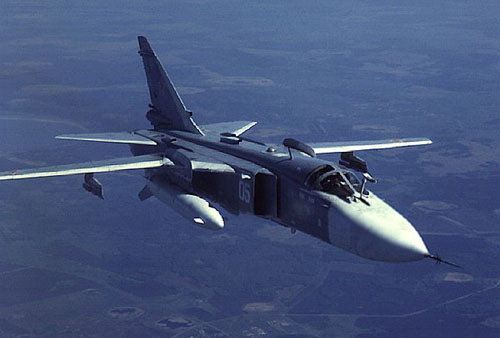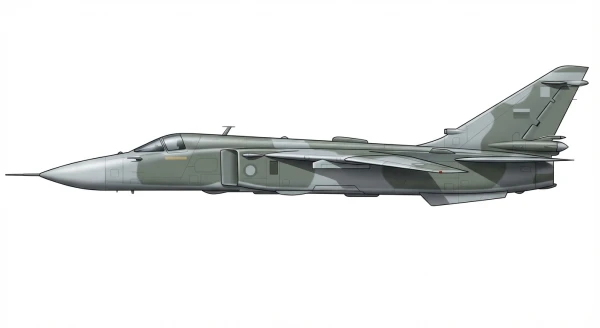Su-24 Fencer
Summary
| Category | Combat Aircraft |
| Origin country | 🇨🇳 Ex-USSR |
| Manufacturer | Sukhoi |
| First flight | 2 July 1967 |
| Year introduced | 1973 |
| Number produced | 1400 units |
| Average unit price | $25 million |
Description
The Sukhoi Su-24 Fencer is a supersonic, all-weather attack aircraft developed by the Soviet Union. It was introduced into service in 1974. The aircraft was designed by the Sukhoi Design Bureau as a replacement for older Soviet ground-attack aircraft like the Sukhoi Su-7 and Su-17. The Su-24 was intended to perform close air support, deep strike, and reconnaissance missions, featuring variable-sweep wings for better performance at various speeds and altitudes. Its design was influenced by the need for greater range, payload, and versatility compared to its predecessors. Over the years, the Su-24 has been exported to various countries and has seen combat in conflicts such as the Afghanistan War, the Chechen Wars, and more recently in Syria.
The development of the Su-24 Fencer began in the late 1960s, driven by the Soviet Union's need for a modern, all-weather, multirole attack aircraft that could outperform its predecessors like the Su-7 and Su-17. One of the unique features of the Su-24 is its variable-geometry wings, commonly known as "swing wings," which could be adjusted to different angles to optimize performance during low-level flight and high-speed operations. This design was influenced by Western aircraft like the F-111 Aardvark.
To meet the requirements of all-weather capability, the Su-24 was equipped with a sophisticated avionics suite, including radar systems that enabled terrain-following flight and precision targeting in adverse weather conditions. The aircraft also featured dual ejection seats to accommodate a pilot and a weapons systems officer, making it easier to manage the complex avionic systems and weaponry during missions.
For armament, the Su-24 was designed to carry a wide array of ordnance, ranging from precision-guided munitions to unguided bombs and rockets. This allowed the aircraft to fulfill roles in close air support, deep strike missions, and reconnaissance. Its capability to carry a significant payload made it particularly useful for long-range missions, which was further bolstered by in-flight refueling capabilities.
Armament
The Su-24 Fencer is equipped with a GSh-6-23 23mm cannon with a high rate of fire for strafing and close air support roles. However, the primary strength of the aircraft lies in its ability to carry a diverse range of ordnance on its multiple hardpoints. The aircraft has a total of eight underwing and two fuselage pylons, capable of carrying a mix of air-to-surface and air-to-air weapons.
In the air-to-surface category, the Su-24 can carry a variety of guided and unguided munitions. These include laser-guided bombs such as the KAB-500L, TV-guided bombs like the KAB-500KR, and unguided FAB series bombs. It can also carry anti-ship missiles like the Kh-31 and Kh-35, as well as air-to-ground missiles like the Kh-25 and Kh-29, which are suitable for attacking fortified positions and armored targets.
For longer-range strike missions, the aircraft can be armed with stand-off weapons like the Kh-59 Ovod, a subsonic air-to-surface cruise missile with a range of up to 115 kilometers. These long-range capabilities make the Su-24 a potent platform for deep-strike missions, allowing it to engage targets well behind enemy lines.
When it comes to air-to-air combat, the Su-24 has limited but functional capabilities. It can carry short-range R-60 (AA-8 Aphid) or R-73 (AA-11 Archer) missiles for self-defense against enemy aircraft. However, air-to-air combat is not its primary role, and it typically relies on escort fighters for protection in airspace with significant aerial threats.
Additionally, the Su-24 can carry a range of electronic countermeasures and jamming pods to disrupt enemy radar and communications, thereby increasing its survivability on the battlefield. The aircraft is also capable of carrying reconnaissance pods for intelligence-gathering missions.
Operational history
The Su-24 Fencer has seen extensive operational service since its introduction in 1974, participating in conflicts across multiple theaters and under different flags.
One of its earliest deployments was in the Soviet-Afghan War, where it was used primarily for ground-attack missions against mujahideen fighters. The rugged Afghan terrain and rudimentary air defenses presented challenges but also validated the aircraft's capabilities for all-weather, day-night operations.
Following the dissolution of the Soviet Union, the Su-24 found its way into the air forces of several former Soviet states. It saw action in the First and Second Chechen Wars, serving in the Russian Air Force for ground-attack and reconnaissance missions. Its role in these conflicts was generally considered effective, despite some losses due to surface-to-air missiles and anti-aircraft fire.
More recently, Su-24s have been used by the Syrian Air Force in the ongoing Syrian Civil War. The aircraft have carried out attacks on various targets, including insurgent positions and civilian areas, a role that has drawn international scrutiny and criticism for indiscriminate bombing.
The Su-24 has also been deployed in the conflict in eastern Ukraine, although information on its operations there is less clear due to the murky nature of the conflict and the involvement of various parties.
The aircraft has been exported to other nations as well, including Algeria, Iran, Libya, and Sudan, among others. Its service in these air forces has been varied, ranging from patrol and deterrent roles to active participation in regional conflicts.
In November 2015, a notable incident occurred when a Russian Su-24 was shot down by a Turkish F-16 near the Turkey-Syria border, leading to diplomatic tensions between Russia and Turkey. The incident highlighted the aircraft's vulnerability to modern air defense systems when operating in a contested environment.
Variants
The Su-24 has spawned several variants over its operational lifespan, each featuring incremental upgrades to enhance performance, avionics, and weapon capabilities. Here are the main variants:
- Su-24 ("Fencer-A"): This is the original production version, which established the core design and capabilities of the aircraft. It featured basic avionics and was primarily intended for daytime, good-weather operations.
- Su-24M ("Fencer-D"): Introduced in 1983, this is the most widespread variant and features substantial upgrades over the original. The "M" stands for "Modernized," and it includes improved avionics, an in-flight refueling probe, and the ability to carry precision-guided munitions. The aircraft's navigation and attack systems were also significantly enhanced, providing better all-weather and night-time capabilities.
- Su-24MK: This is the export version of the Su-24M and is very similar in capabilities. It has been sold to various countries, including Algeria, Iran, and Libya.
- Su-24MR ("Fencer-E"): This is a dedicated reconnaissance variant, fitted with specialized equipment for gathering intelligence. It is devoid of internal cannons to make room for additional reconnaissance gear, such as high-resolution cameras and electronic surveillance systems.
- Su-24MP ("Fencer-F"): This is an electronic warfare (EW) and electronic intelligence (ELINT) variant. It is equipped with jammers and systems designed to intercept and analyze enemy electronic transmissions.
- Su-24M2: This is a further upgrade of the Su-24M, featuring modernized avionics and the ability to use newer types of air-to-surface weapons, including advanced precision-guided munitions. Introduced in 2000, this version aimed to extend the aircraft's operational life and improve its combat effectiveness.
Technical specifications
| Version: Su-24M Fencer-D | |
|---|---|
| Crew | 1 pilot + 1 WSO |
| Operational range | 3,900 km (2,423 mi) |
| Maximum speed | 1450 km/h (901 mph) |
| Wing area | 46.4 m² (499.4 sqft) |
| Wingspan | 17.6 m (57.9 ft) |
| Height | 6.2 m (20.3 ft) |
| Length | 24.5 m (80.5 ft) |
| Service ceiling | 16,500 m (54,134 ft) |
| Empty weight | 22,320 kg (49,207 lbs) |
| Max. takeoff weight | 39,700 kg (87,523 lbs) |
| Takeoff distance | 850 m (2,789 ft) |
| Powerplant | 2 x turbojets AL-21F3 delivering 7787 kgf each |
| Ejection seat | Zvezda K-36DM |
Current operating countries
| Country | Units | ||
|---|---|---|---|

|
Russia | 296 | |

|
Algeria | 42 | |

|
Iran | 21 | |

|
Syria | 18 | |

|
Ukraine | 13 | |

|
Sudan | 7 | |

|
Libya | 2 | |
All operators
Armament
Missiles payload:
- Anti-Radiation Raduga Kh-58 (AS-11 Kilter)
- Air-to-Surface Raduga Kh-59 Ovod (AS-13 Kingbolt)
- Air-to-Surface Raduga Kh-59M Ovod-M (AS-18 Kazoo)
- Air-to-Surface Vympel Kh-25 (AS-10 Karen)
- Air-to-Surface Vympel Kh-29 (AS-14 Kedge)
- Anti-Radiation Vympel Kh-31 Taifun (AS-17 Krypton)
- Air-to-Air Short-Range Vympel R-60 / K-60 (AA-8 Aphid)
Bombs payload:
- Low-Drag FAB-1500
- Guided KAB-500
- Guided KAB-1500


